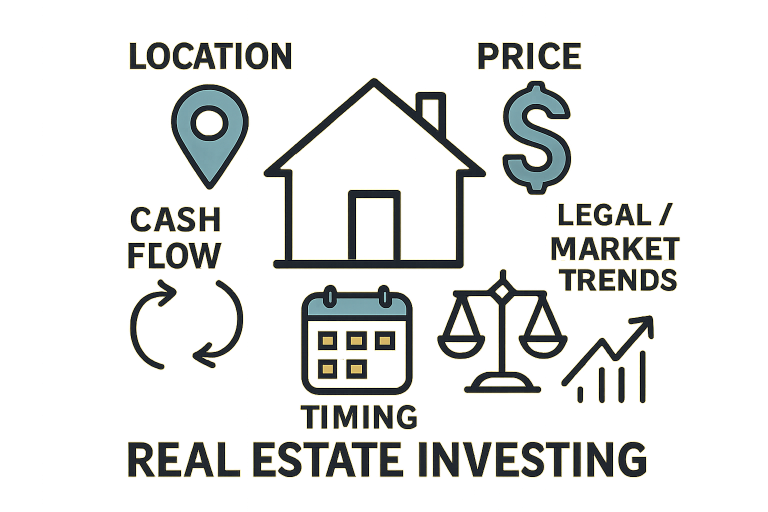Now Reading: The Essential Factors to Consider When Investing in Real Estate Properties
-
01
The Essential Factors to Consider When Investing in Real Estate Properties
The Essential Factors to Consider When Investing in Real Estate Properties

Key Takeaways
- Location has a profound impact on property value and investment potential.
- Thorough property valuation methods prevent overpaying and support informed investment decisions.
- Clarifying your objectives and timeline is fundamental before making any real estate purchase.
- Positive cash flow is essential for long-term financial success.
- Understanding economic trends, property condition, and legalities guides risk mitigation and future growth.
Location: The Cornerstone of Real Estate Investment
It cannot be overstated: the value and success of any real estate investment hinge significantly on location. This primary factor drives everything from appreciation potential and demand to tenant retention and resale viability. Proximity to schools, employment centers, amenities, and public transportation has a direct impact on desirability—and thus, property values over time. Industry experts, such as Charles Nabit, frequently highlight location as an initial screening criterion for successful investing.
Understanding neighborhood dynamics, such as upcoming development plans, public infrastructure projects, and even changes in crime rates, can give savvy investors a critical edge. Such factors dictate whether an area is poised for rapid growth or steady stability, or if it faces waning interest. Investing in a rising locale can mean profits, while a declining neighborhood could spell loss, no matter the property’s inherent merits.
Property Valuation: Determining the Right Price
Determining accurate property value is essential for budgeting, financing, tax assessment, and planning for future returns. Investors rely on several standard valuation techniques to avoid the pitfalls of overpaying or underestimating the investment potential. The sales comparison approach weighs the market price of similar nearby buildings, the cost approach factors in what it would take to rebuild the property from scratch minus depreciation, and the income approach centers on potential cash flow, especially important for rental properties. According to Investopedia, understanding these valuation methods thoroughly can help investors make informed decisions and mitigate financial risks. Applying these methods objectively enables buyers to set realistic expectations and negotiate more favorable deals. It also reveals how the asset’s features compare to market norms, which can inform both purchase and exit strategies.
Investment Purpose and Horizon: Aligning Goals with Strategy
Before writing an offer or pursuing a mortgage, investors should clarify their intent and expected timeline. For some, real estate offers an avenue to long-term appreciation and retirement planning; for others, it presents immediate income via rentals or short-term gains through renovations and flips. Each approach carries distinct risk profiles, financing structures, and management demands. Aligning a matching strategy with personal goals and financial circumstances is crucial to minimizing risk and maximizing satisfaction.
Investors should also assess market cycles—opting for long holds in stable times, or quick sales during peaks—to optimize their approach. Assessing your comfort with risk and patience for returns is as crucial as evaluating the property condition itself.
Cash Flow and Profit Potential: Ensuring Financial Viability
Cash flow lies at the heart of sustainable real estate investing. Investors must ensure that rental income or other property-generated revenue consistently outpaces mortgage payments, maintenance, insurance, taxes, and reserves for unexpected costs. Positive cash flow not only maintains healthy finances but also cushions against market shifts and vacancies.
Critical due diligence should include research on vacancy rates, average market rents, and realistic expense forecasting. A clear-eyed assessment can prevent properties from becoming liabilities, regardless of their future appreciation potential.
Economic Indicators: Gauging Market Health
Successful investment increasingly hinges on reading broader economic signals. Regional GDP growth, job creation, unemployment levels, and inflation powerfully impact housing demand. For example, cities with robust economies often experience greater rental demand and property price surges. Incorporating economic insights into your real estate research enables more proactive, less reactive decision-making, often distinguishing successful investors from the rest.
Property Condition and Maintenance: Assessing Upkeep Needs
The structural integrity, age, and maintenance history of a property dramatically affect both its current and future value. Hidden repair needs, outdated systems, or impending capital expenditures can significantly impact profit projections. Professional home inspections, a thorough review of maintenance logs, and an estimate of necessary upgrades are all prudent steps to take before closing a deal. This due diligence not only preserves ROI but also protects against nasty surprises down the line.
Legal and Regulatory Considerations: Navigating Compliance
Every property is subject to a complex legal matrix, encompassing zoning ordinances, environmental regulations, tax codes, and tenant-landlord laws. Noncompliance can prompt fines, lawsuits, or outright restrictions on property use. Experienced investors consult with legal and tax professionals to ensure that every facet of an acquisition—from intended use to lease agreements—meets local, state, and federal requirements—such vigilance guards against risk and streamlines operations across their real estate portfolio.
Market Trends: Staying Ahead of the Curve
Shifting demographics, changes in lifestyle (such as the increase in remote work), and evolving lending rates all shape market supply and demand. An astute investor stays attuned to these trends, seeking out data-driven forecasts and new patterns in buyer and tenant behavior. Adapting your approach to what’s just over the horizon allows not just for survival but for outperformance in a competitive market. Whether pivoting toward suburban investments, focusing on multifamily units, or seeking mixed-use developments, staying informed about trends enables a flexible and profitable approach.
Conclusion
Making a wise real estate investment goes far beyond price per square foot. By holistically evaluating critical factors—location, property valuation, investment goals, cash flow, economic conditions, property condition, the legal landscape, and constantly-evolving market trends—you position yourself for enduring returns and lower risk. Each step, thoughtfully addressed, moves you closer to profitable and sustainable real estate investing, aligning with your unique financial aspirations.





















